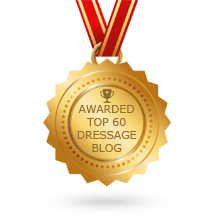|
Historically, the type of dressage training shown in a competition was based on classical dressage principles. It was a way for a rider to check their horse’s training and have some input on which areas needed to be developed with their horse. However, as competition dressage became more focused on the rewards of competing, placings and rosettes, riders began to look at their next test to direct the training and the test itself became the training manual. The modern dressage training used today came to the fore during the 1980’s, when we began to see riders competing on horses trained in a new system that created horses with greatly exaggerated fore leg movement and a compressed frame at the expense of correct action of the haunches and hind leg. As the early proponents of the system became more successful, the method was copied, and by the 1990’s it was accepted as the correct way for horses to perform the movements, rapidly filtering down into mainstream equestrian practice. This system was criticised by advocates of classical dressage. The debate on the values and method of training being shown and judged as correct became louder. Initially the FEI sought to resolve the issue by adjusting the existing rules and advice to better reflect what was being shown in the arena. This only pushed the debate further as it did not address the most significant point argued by the supporters of classical dressage. The main concern was the pressure that riders applied to horses via the use of rollkur. Horses continued to be presented in world competitions with riders using extreme force to bring their horse’s head in, with the use of ever tighter nosebands to prevent the horse opening its mouth, and their mounts showing greater signs of great distress. Occasionally blood could be seen in the horse’s mouth or on their sides from the rider’s spurs. Finally, the FEI were compelled to resolve the situation that had developed and, following a conference, they banned rollkur but continued to allow the use of low deep and round for short periods of time. Did this change anything in training methods used? Many trainers and riders and began to call themselves a Classical Trainer yet did not modify their techniques away from rollkur or change the forceful techniques that they had previously used. Classical dressage centres on the process of training, and purity of the gaits which take more time to develop than modern techniques. Dressage training should result in a strong, supple, well-balanced horse and is soft in the contact and responds to the lightest aid from the rider. There should be an overall quality of lightness in all work which is the result of self-carriage with no tension in the reins, with a loose fitting nose band that allows the horse to move its mouth. The horse’s neck should be lengthened, stretching up and forward from the withers, and there should be free movement in the horse’s legs and shoulders. Whilst modern dressage began with classical principles, it has moved further away from those ideals and is now barely recognisable as the same thing. For comparison the pictures below show horses in the same movement, on the left, horses trained with modern methods, and on the right, horses trained with classical techniques. © Training Riders, Transforming Horses
|
AuthorDiane Followell Classical Dressage Trainer 
|
Telephone+44 (0)7931551014
|
|
© Diane Followell 2015 -2024.
All Rights Reserved.
All images and content are copyright Diane Followell unless otherwise stated.
All Rights Reserved.
All images and content are copyright Diane Followell unless otherwise stated.



 RSS Feed
RSS Feed

